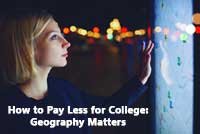 Last September a group of 80 colleges announced a new college application designed to improve access, affordability, and success. They actually call themselves the Coalition for Access, Affordability, and Success. But for some reason, the counselors who work with high school students, both private and school-based, don’t seem impressed with the new option. Maybe because the Coalition apparently hasn’t even piloted the application yet or listed any committed Community Based Organizations?
Last September a group of 80 colleges announced a new college application designed to improve access, affordability, and success. They actually call themselves the Coalition for Access, Affordability, and Success. But for some reason, the counselors who work with high school students, both private and school-based, don’t seem impressed with the new option. Maybe because the Coalition apparently hasn’t even piloted the application yet or listed any committed Community Based Organizations?
Costs
How to Pay Less for College: Avoid Goldilocks Colleges
 I started off this series of How to Pay Less for College by discussing how the economics of supply and demand are the basis for cutting the cost of college. The next two posts on college rankings and geography were basically explaining two significant elements that affect how much families will pay for college. Today I want to talk about a third factor that falls under the supply and demand of college admissions: college size.
I started off this series of How to Pay Less for College by discussing how the economics of supply and demand are the basis for cutting the cost of college. The next two posts on college rankings and geography were basically explaining two significant elements that affect how much families will pay for college. Today I want to talk about a third factor that falls under the supply and demand of college admissions: college size.
How to Pay Less for College: Geography Matters
 As someone who recently bought a house in an economically booming market, I can tell you the same house costs a lot more near the city center than out in the suburbs. My husband and I looked at the trade-offs in terms of travel time and cost and for us, the suburbs made sense. We don’t live in Austin, we are actually in the extraterritorial jurisdiction of the city of Hutto. And despite the Hippo fetish, we’re good with that.
As someone who recently bought a house in an economically booming market, I can tell you the same house costs a lot more near the city center than out in the suburbs. My husband and I looked at the trade-offs in terms of travel time and cost and for us, the suburbs made sense. We don’t live in Austin, we are actually in the extraterritorial jurisdiction of the city of Hutto. And despite the Hippo fetish, we’re good with that.
How does this have anything to do with how to pay less for college? Because how much you pay for college can depend on location.
How to Pay Less for College: The Value of Rankings
 In my last post, I talked about how even colleges are subjected to the laws of supply and demand. The more students want to attend a college, the more the college can charge. If you want to pay less for college, you need to consider colleges with higher acceptance rates. Now I want to look at why so many students are interested in the same college. What makes 50 or fewer colleges so much more attractive than the remaining 1,500? Can you say “college rankings?”
In my last post, I talked about how even colleges are subjected to the laws of supply and demand. The more students want to attend a college, the more the college can charge. If you want to pay less for college, you need to consider colleges with higher acceptance rates. Now I want to look at why so many students are interested in the same college. What makes 50 or fewer colleges so much more attractive than the remaining 1,500? Can you say “college rankings?”
What’s Wrong with These 135 Colleges…and Does it Matter?
 You may have missed the excitement last May when Ronald Nelson announced he was going to attend the University of Alabama. This was a big deal not because Alabama had grabbed the top football recruit in the nation. It was a big deal because Nelson was actually accepted at all eight Ivy League schools, Stanford, Johns Hopkins, and Washington University in St. Louis. He turned them all down to attend the honors college at the University of Alabama.
You may have missed the excitement last May when Ronald Nelson announced he was going to attend the University of Alabama. This was a big deal not because Alabama had grabbed the top football recruit in the nation. It was a big deal because Nelson was actually accepted at all eight Ivy League schools, Stanford, Johns Hopkins, and Washington University in St. Louis. He turned them all down to attend the honors college at the University of Alabama.
50-50 Highlights: Is Your College Degree Worth More Than a High School Diploma?
 Something happened this weekend that most families trying to figure out how to pick and pay for college missed–and most colleges are probably good with this. This weekend the government released a revised College Scorecard that lets users filter schools based on graduation rates, average annual costs, and graduate median salary. Better yet, all the data collected (although not necessarily used) by the College Scorecard was also released for downloading. Guess what I’ve been doing since Sunday?
Something happened this weekend that most families trying to figure out how to pick and pay for college missed–and most colleges are probably good with this. This weekend the government released a revised College Scorecard that lets users filter schools based on graduation rates, average annual costs, and graduate median salary. Better yet, all the data collected (although not necessarily used) by the College Scorecard was also released for downloading. Guess what I’ve been doing since Sunday?
50-50 Highlights: 28 Colleges with the Best ROI That You Can Actually Get Into
 Money’s Best Colleges is one of the increasing alternatives to US News Best College Rankings. According to Washington Post, “Money Magazine’s new college rankings finally get it right for students” since it focuses on the cost to the student and likely return on investment. I’m not willing to declare Money’s College Rankings as the way rankings should be done, but I will acknowledge that it’s a step in the right direction.
Money’s Best Colleges is one of the increasing alternatives to US News Best College Rankings. According to Washington Post, “Money Magazine’s new college rankings finally get it right for students” since it focuses on the cost to the student and likely return on investment. I’m not willing to declare Money’s College Rankings as the way rankings should be done, but I will acknowledge that it’s a step in the right direction.
84 Best Bet Public Universities for Meeting Financial Need
 (Based on some readers comments, I just want to clarify that the schools on this list at the end of the post are only “Best Bets” for residents of the state. Out-of-state students shouldn’t expect any financial assistance from these schools.) If there is a list of the top three things families entering the college search process must know, one of them would have to be that very few colleges meet 100% of need. Just because the federal government and the institution recognize a specific amount of need doesn’t mean the student will receive a matching amount of financial aid. This is why lists of colleges that meet 100% of need are very popular.
(Based on some readers comments, I just want to clarify that the schools on this list at the end of the post are only “Best Bets” for residents of the state. Out-of-state students shouldn’t expect any financial assistance from these schools.) If there is a list of the top three things families entering the college search process must know, one of them would have to be that very few colleges meet 100% of need. Just because the federal government and the institution recognize a specific amount of need doesn’t mean the student will receive a matching amount of financial aid. This is why lists of colleges that meet 100% of need are very popular.
Does Getting An Ivy League Education Mean That You Belittle Those Who Choose Not To?
 Curses on you Google Alerts! I managed to go over two years without paying any attention to the Ivy Coach blog. But last Friday while going through my weekly Google alerts for information on college admissions, I managed to click on links related to The Ivy Coach twice!
Curses on you Google Alerts! I managed to go over two years without paying any attention to the Ivy Coach blog. But last Friday while going through my weekly Google alerts for information on college admissions, I managed to click on links related to The Ivy Coach twice!

